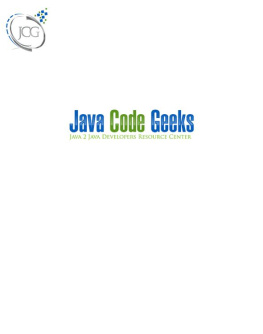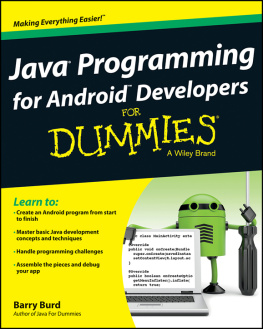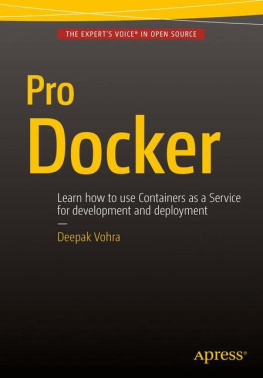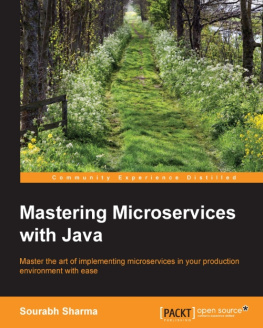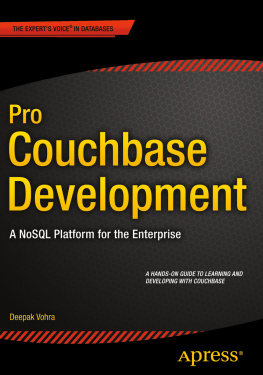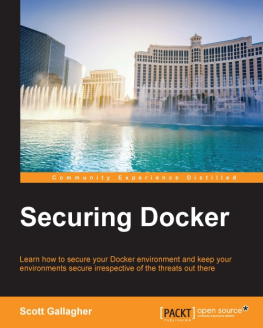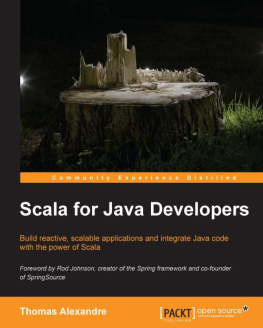JavaCodeGeeks - Docker for Java Developers
Here you can read online JavaCodeGeeks - Docker for Java Developers full text of the book (entire story) in english for free. Download pdf and epub, get meaning, cover and reviews about this ebook. year: 2018, genre: Computer. Description of the work, (preface) as well as reviews are available. Best literature library LitArk.com created for fans of good reading and offers a wide selection of genres:
Romance novel
Science fiction
Adventure
Detective
Science
History
Home and family
Prose
Art
Politics
Computer
Non-fiction
Religion
Business
Children
Humor
Choose a favorite category and find really read worthwhile books. Enjoy immersion in the world of imagination, feel the emotions of the characters or learn something new for yourself, make an fascinating discovery.
- Book:Docker for Java Developers
- Author:
- Genre:
- Year:2018
- Rating:5 / 5
- Favourites:Add to favourites
- Your mark:
- 100
- 1
- 2
- 3
- 4
- 5
Docker for Java Developers: summary, description and annotation
We offer to read an annotation, description, summary or preface (depends on what the author of the book "Docker for Java Developers" wrote himself). If you haven't found the necessary information about the book — write in the comments, we will try to find it.
Docker for Java Developers — read online for free the complete book (whole text) full work
Below is the text of the book, divided by pages. System saving the place of the last page read, allows you to conveniently read the book "Docker for Java Developers" online for free, without having to search again every time where you left off. Put a bookmark, and you can go to the page where you finished reading at any time.
Font size:
Interval:
Bookmark:

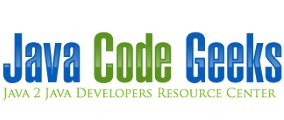
Docker for Java Developers
If you have not heard about Docker, then you have probably spent the last few years on some other planet of the Solar system. Docker stormed into our industry and in no time dramatically changed many well-established software development and operational practices and patterns. These days pretty much every organization is using Docker (or equivalent of it), the brave ones even in production, and its adoption is growing at fantastic pace.
In this tutorial we are going to talk about how Docker can help us, Java developers, in accomplishing our day to day tasks. The tutorial consists of several parts where we going to touch upon different aspects of Docker and its applicability to Java applications development.
We will start off by learning the basics:
- Why we should invest our time in learning Docker
- Get to know Docker command line tooling
- Using REST faade to talk to Docker
Then we will move on to the topics related specifically to Docker in context of Java applications right after:
- Building
- Developing
- Testing
- Deploying
- Continuous Integration / Delivery
The material we will be going through assumes that you have some basic familiarity with Docker and have at least version 17.06.1-ce already installed on the machine (it does not really matter if you are on Linux, Windows or Mac per se).
The story, which made Docker and friends possible, begins back in 2006, when a couple of awesome engineers at Google started the work on the feature under the name process containers. It was later rebranded to control groups (or cgroups as we know them today) and was merged into the Linux kernel starting from version 2.6.24, released in January 2008.
Essentially, cgroups is a Linux kernel feature that limits, accounts for, prioritizes and isolates the resource usage (CPU, memory, disk I/O, network, etc.) of processes. Most importantly, to support all that the Linux kernel does not need to start any virtual machines or hypervisors. Along with namespaces, another very powerful feature of the Linux kernel, cgroups serve as a fundamental building block for containers: operating system-level virtualization.
Container-based virtualization is exceptionally lightweight (comparing to traditional virtual machines), imposes little to no overhead, share the same operating system kernel and do not require special hardware support to perform efficiently. To say it in other words, containers become a new model to wrap the applications so they could be run in isolation on a shared operating system. Although not without the limitations, going with containers becomes a mainstream in the virtualization space nowadays.
To be fair, not all Linux/Unix distributions use the same mechanisms for operating system-level virtualization. To mention a couple of examples, FreeBSD has jails for such purposes while Solaris has the concept of zones.
So, how to get started with containers? Well, you may have heard abbreviations like LXC or LXD which are essentially the entry points for containers management on most of the Linux/Unix distributions. The thing is, those are somewhat low-level and not easy to start with. But luckily we have Docker and rkt, the application-centric container management engines, which right from the inception became the de facto choices for the application developers across the globe.
So what is Docker essentially? It started off as a powerful and easy to use container engine but these days it would be fair to call it a full-fledged container management platform. It is written in Go and takes advantage of the Linux kernel features (mostly namespaces and cgroups) to do the job. The community edition is downloadable free of charge whereas the enterprise edition is also available through subscription offerings. To settle the stage, along this tutorial we are going to use the features of the community edition only.
From the architectural perspective, Docker consists of three main parts. In the heart of Docker sits the daemon process, dockerd. In turn, dockerd relies on another daemon, containerd, as the abstraction layer to interface with the Linux kernel namespaces and cgroups. The last piece of the puzzle is a set of command line tools (like for example docker and docker-compose), known as Docker CLI, which are able to talk to dockerd daemon though the Docker Engine API it exposes.
Each of the Docker components mentioned above deserves own tutorial, so many interesting features and capabilities they provide, though our focus would be primarily centered on Docker Engine API and the Docker CLI family (docker and docker-compose).
One of the strongest arguments in favor of choosing Docker is that it runs natively on the majority of the Linux distributions but it does not stop there. macOS and Windows operating systems are also supported pretty well, with a few caveats to be aware of.
In order to understand how Docker works, we have to unveil a bit its internal model. At any time, if you feel like there are not enough details uncovered about the subject, please do not hesitate to consult the official documentation.
In Docker, everything you do is managing the specific objects. Images and containers are arguably the most important ones however there are others like volumes, networks and plugins, to name a few. All of them we are going to see in action in different sections of the tutorial, starting with images and containers right away.
Image could be treated as a set of instructions on how to create the container. In Docker, one image could be inherited (or based on) from another image, adding additional instructions on top of base ones. Each image consists of multiple layers, which are effectively immutable. Under the hood these layers are backed by dedicated file systems (by default UnionFS, but others could be plugged in as well), making them very lightweight and fast.
So how could you create such images for your own needs? It is actually pretty simple, to build your own image in s may look like, here is a quick example:
1 | FROM alpine:3.6 |
2 | CMD ["uname","-a"] |
Each instruction in a Dockerfile creates a new layer so at the end each image has a list of immutable layers, stacked on top of each other, that represent the filesystem differences.
In the upcoming sections we will be writing quite a lot of different Dockerfiles, closely following the best practices and recommendations.
When you have your images ready, it is time to bring them to live. Here is where the containers appear on the stage: they are runnable instances of the images. You can run as many of them as your want, assuming the target host (where Docker is installed) has enough resources. All of that is feasible because the containers are well isolated from each other, at least by default (however you have quite a lot of options to control that).
When Docker creates an instance of the
Font size:
Interval:
Bookmark:
Similar books «Docker for Java Developers»
Look at similar books to Docker for Java Developers. We have selected literature similar in name and meaning in the hope of providing readers with more options to find new, interesting, not yet read works.
Discussion, reviews of the book Docker for Java Developers and just readers' own opinions. Leave your comments, write what you think about the work, its meaning or the main characters. Specify what exactly you liked and what you didn't like, and why you think so.

